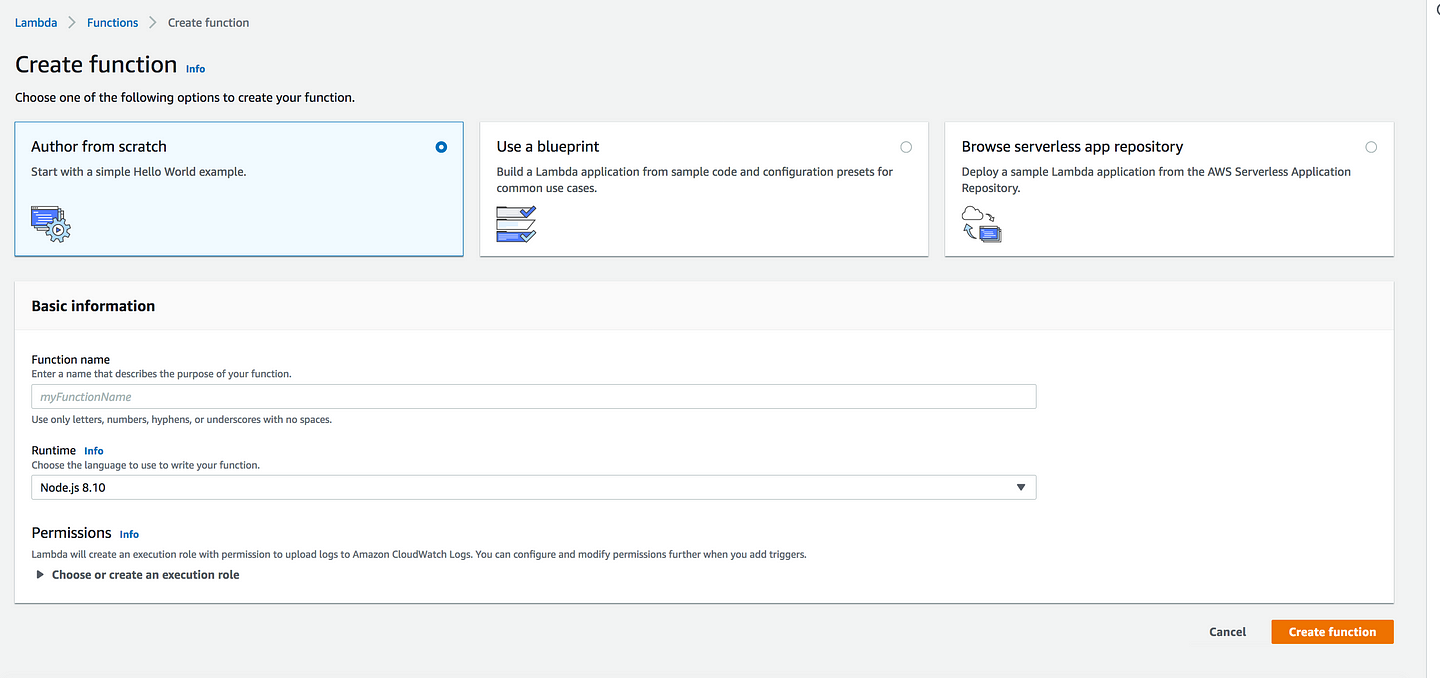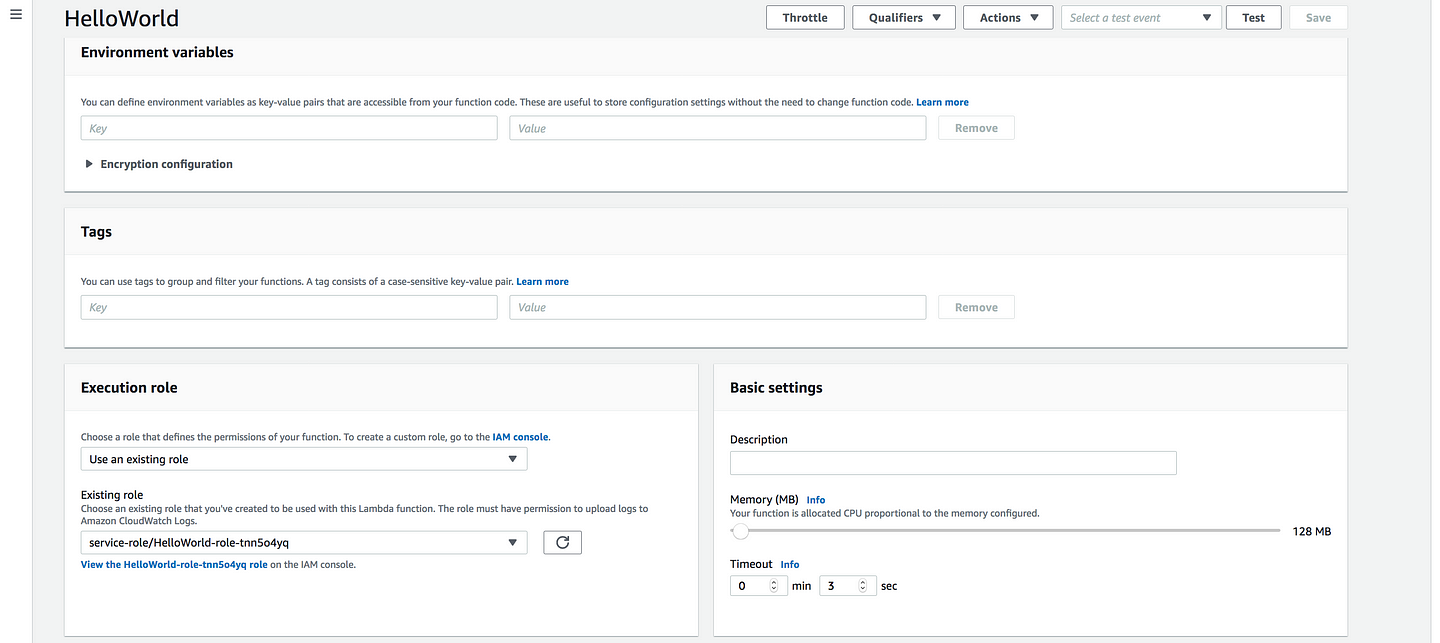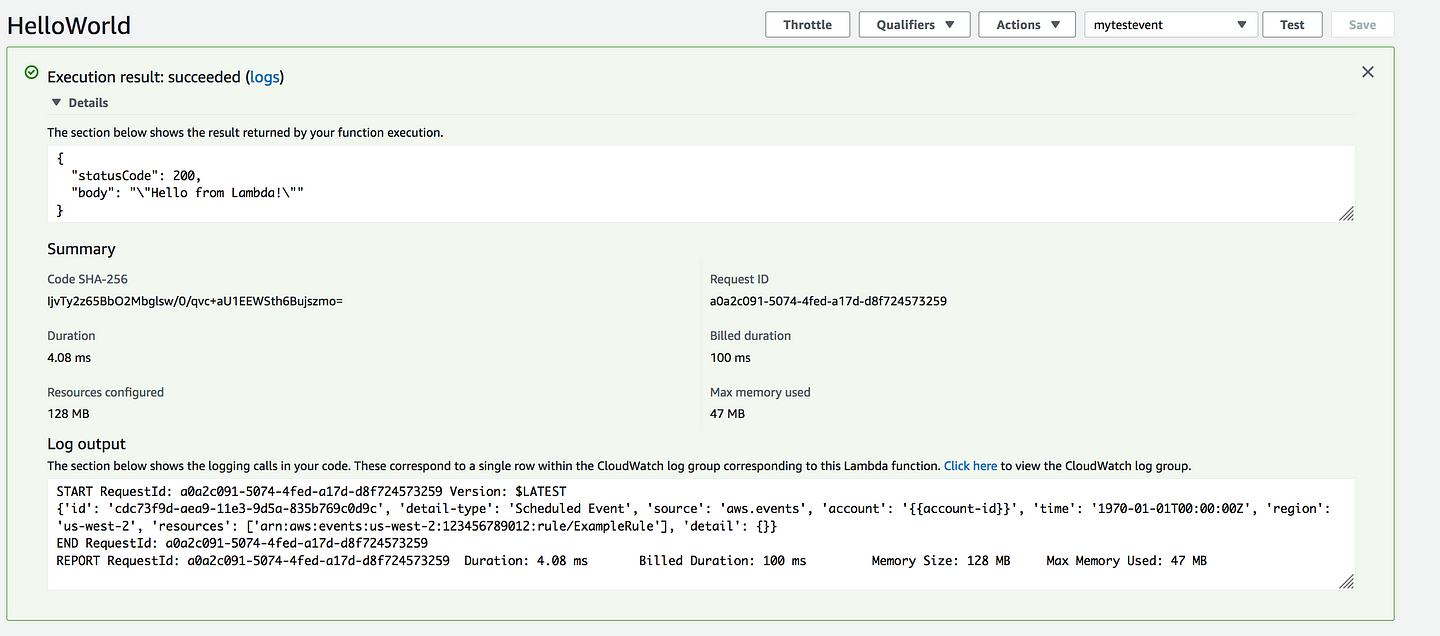What is AWS Lambda?
With AWS Lambda, you can run code without provisioning or managing servers. You pay only for the compute time that you consume — there’s no charge when your code isn’t running. You can run code for virtually any type of application or backend service — all with zero administration. Just upload your code and Lambda takes care of everything required to run and scale your code with high availability. You can set up your code to automatically trigger from other AWS services or call it directly from any web or mobile app.
- To start with Lambda
Go to https://us-west-2.console.aws.amazon.com/lambda → Create a function


- Create function you have three options
* Author from scratch: Which is self explanatory, i.e you are writing your own function * Use a blueprint: Build a lambda application from sample code and configuration preset for common use cases (Provided by AWS) * Browse serverless app repository: Deploy a sample lambda application from the AWS Serverless Application Repository(Published by other developers and AWS Patners)
- Function name: HelloWorld
- Runtime: Choose Python3.7 from the dropdown
- Permission: For the time being choose the default permission
- Click Create Function



Invoking Lambda Function
- When building applications on AWS Lambda the core components are Lambda functions and event sources. An event source is the AWS service or custom application that publishes events, and a Lambda function is the custom code that processes the events
* Amazon S3 Pushes Events
* AWS Lambda Pulls Events from a Kinesis Stream
* HTTP API requests through API Gateway
* CloudWatch Schedule Events


- From the list select CloudWatch Events

NOTE: It’s an old slide, GO is already supported

- As you can see under CloudWatch Events it says configuration required

- Rule: Create a new rule
- Rule name: Everyday
- Rule description: Give your Rule some description
- Rule type: Choose Schedule expression and under its rate(1 day)(i.e its going to trigger it every day)
- Click on Add and Save
- Now go back to your Lambda Code(HelloWorld)
import json
def lambda_handler(event, context):
# TODO implement
print(event) <--------
return {
'statusCode': 200,
'body': json.dumps('Hello from Lambda!')
}
- Add this entry, which simply means we are trying to print the event
- Again save it
- Let’s try to set a simple test event, Click on Test

- Under Event template, search for Amazon CloudWatch

- Event Name: Give your event some name and test it

- Go back and this time Click on Monitoring

- Click on View logs in CloudWatch

- Click on the log stream and you will see the same logs you see in Lambda console

Lambda Programming Model
- Lambda supports a bunch of programming languages

- You write code for your Lambda function in one of the languages AWS Lambda supports. Regardless of the language you choose, there is a common pattern to writing code for a Lambda function that includes the following core concepts.
* Handler: Handler is the function AWS Lambda calls to start execution of your Lambda function, it act as an entry point.

- As you can see handle start with lambda_function which is a Python Script Name and then lambda_handler which is a function and act as an entry point for event and context
- Event: We already saw in the previous example where we passed the CloudWatch Event to our code
- Context — AWS Lambda also passes a context object to the handler function, as the second parameter. Via this context object, your code can interact with AWS Lambda. For example, your code can find the execution time remaining before AWS Lambda terminates your Lambda function.
- Logging — Your Lambda function can contain logging statements. AWS Lambda writes these logs to CloudWatch Logs.
- Exceptions — Your Lambda function needs to communicate the result of the function execution to AWS Lambda. Depending on the language you author your Lambda function code, there are different ways to end a request successfully or to notify AWS Lambda an error occurred during the execution.
- One more thing, I want to highlight is the timeout

- You can now set the timeout value for a function to any value up to 15 minutes. When the specified timeout is reached, AWS Lambda terminates execution of your Lambda function. As a best practice, you should set the timeout value based on your expected execution time to prevent your function from running longer than intended.
Common Use case of Lambda

Terraform Code
All the steps we have performed manually. let’s try to automate it using terraform
- Step1: Create your test Python function
def lambda_handler(event, context):
print ("Hello from terraform world")
return "hello from terraform world"
- Now let’s zip it up
$ zip lambda.zip lambda.py
adding: lambda.py (deflated 27%)- Step2: Define your Lambda resource
resource "aws_lambda_function" "test_lambda" {
filename = "lambda.zip"
function_name = "lambda_handler"
role = "${aws_iam_role.iam_for_lambda.arn}"
handler = "lambda.lambda_handler"
# The filebase64sha256() function is available in Terraform 0.11.12 and later
# For Terraform 0.11.11 and earlier, use the base64sha256() function and the file() function:
# source_code_hash = "${base64sha256(file("lambda_function_payload.zip"))}"
source_code_hash = "${base64sha256("lambda.zip")}"
runtime = "python2.7"
}
- filename: Is the name of the file, you zipped in the previous step
- function name: Is the name of the function you defined in your python code
- role: IAM role attached to the Lambda Function. This governs both who / what can invoke your Lambda Function, as well as what resources our Lambda Function has access to
- handler: Function entry point in our code(python code filename.method name) (filename: lambda.py we don’t need to include file extension) and (lambda function is lambda_handler def lambda_handler(event, context))
- source_code_hash: Used to trigger updates. Must be set to a base64-encoded SHA256 hash of the package file specified with either
filenameors3_key. The usual way to set this isfilebase64sha256("file.zip")(Terraform 0.11.12 and later) orbase64sha256(file("file.zip"))(Terraform 0.11.11 and earlier), where “file.zip” is the local filename of the lambda function source archive. - Runtime: The identifier of the function’s runtime
Valid Values: nodejs8.10 | nodejs10.x | java8 | python2.7 | python3.6 | python3.7 | dotnetcore1.0 | dotnetcore2.1 | go1.x | ruby2.5 | provided
- Step3: Create an IAM Role
resource "aws_iam_role" "iam_for_lambda" {
name = "iam_for_lambda"
assume_role_policy = <<EOF
{
"Version": "2012-10-17",
"Statement": [
{
"Action": "sts:AssumeRole",
"Principal": {
"Service": "lambda.amazonaws.com"
},
"Effect": "Allow",
"Sid": ""
}
]
}
EOF
}
# See also the following AWS managed policy: AWSLambdaBasicExecutionRole
resource "aws_iam_policy" "lambda_logging" {
name = "lambda_logging"
path = "/"
description = "IAM policy for logging from a lambda"
policy = <<EOF
{
"Version": "2012-10-17",
"Statement": [
{
"Action": [
"logs:CreateLogStream",
"logs:PutLogEvents"
],
"Resource": "arn:aws:logs:*:*:*",
"Effect": "Allow"
}
]
}
EOF
}
resource "aws_iam_role_policy_attachment" "lambda_logs" {
role = "${aws_iam_role.iam_for_lambda.name}"
policy_arn = "${aws_iam_policy.lambda_logging.arn}"
}
Reference https://www.terraform.io/docs/providers/aws/r/lambda_function.html
- Step4: Terraform Init: Initialize a Terraform working directory, containing Terraform configuration files. This is the first command that should be run after writing a new Terraform configuration or cloning an existing one from version control.
$ terraform init
Initializing provider plugins...
- Checking for available provider plugins on https://releases.hashicorp.com...
- Downloading plugin for provider "aws" (2.23.0)...
The following providers do not have any version constraints in configuration,
so the latest version was installed.
To prevent automatic upgrades to new major versions that may contain breaking
changes, it is recommended to add version = "..." constraints to the
corresponding provider blocks in configuration, with the constraint strings
suggested below.
* provider.aws: version = "~> 2.23"
Terraform has been successfully initialized!
You may now begin working with Terraform. Try running "terraform plan" to see
any changes that are required for your infrastructure. All Terraform commands
should now work.
If you ever set or change modules or backend configuration for Terraform,
rerun this command to reinitialize your working directory. If you forget, other
commands will detect it and remind you to do so if necessary.- Step5: Terraform plan: The
terraform plancommand is used to create an execution plan. Terraform performs a refresh, unless explicitly disabled, and then determines what actions are necessary to achieve the desired state specified in the configuration files.
$ terraform plan
Refreshing Terraform state in-memory prior to plan...
The refreshed state will be used to calculate this plan, but will not be
persisted to local or remote state storage.
------------------------------------------------------------------------
An execution plan has been generated and is shown below.
Resource actions are indicated with the following symbols:
+ create
Terraform will perform the following actions:
+ aws_cloudwatch_log_group.example
id: <computed>
arn: <computed>
name: "/aws/lambda/lambda_handler"
retention_in_days: "14"
+ aws_iam_policy.lambda_logging
id: <computed>
arn: <computed>
description: "IAM policy for logging from a lambda"
name: "lambda_logging"
path: "/"
policy: "{\n \"Version\": \"2012-10-17\",\n \"Statement\": [\n {\n \"Action\": [\n \"logs:CreateLogStream\",\n \"logs:PutLogEvents\"\n ],\n \"Resource\": \"arn:aws:logs:*:*:*\",\n \"Effect\": \"Allow\"\n }\n ]\n}\n"
+ aws_iam_role.iam_for_lambda
id: <computed>
arn: <computed>
assume_role_policy: "{\n \"Version\": \"2012-10-17\",\n \"Statement\": [\n {\n \"Action\": \"sts:AssumeRole\",\n \"Principal\": {\n \"Service\": \"lambda.amazonaws.com\"\n },\n \"Effect\": \"Allow\",\n \"Sid\": \"\"\n }\n ]\n}\n"
create_date: <computed>
force_detach_policies: "false"
max_session_duration: "3600"
name: "iam_for_lambda"
path: "/"
unique_id: <computed>
+ aws_iam_role_policy_attachment.lambda_logs
id: <computed>
policy_arn: "${aws_iam_policy.lambda_logging.arn}"
role: "iam_for_lambda"
+ aws_lambda_function.test_lambda
id: <computed>
arn: <computed>
filename: "lambda.zip"
function_name: "lambda_handler"
handler: "lambda.lambda_handler"
invoke_arn: <computed>
last_modified: <computed>
memory_size: "128"
publish: "false"
qualified_arn: <computed>
reserved_concurrent_executions: "-1"
role: "${aws_iam_role.iam_for_lambda.arn}"
runtime: "python2.7"
source_code_hash: "Gpu07NPcj26NrKv0Ne6BbZkfDRuM3ozHHqCFUWH9Sqg="
source_code_size: <computed>
timeout: "3"
tracing_config.#: <computed>
version: <computed>
Plan: 5 to add, 0 to change, 0 to destroy.
------------------------------------------------------------------------
Note: You didn't specify an "-out" parameter to save this plan, so Terraform
can't guarantee that exactly these actions will be performed if
"terraform apply" is subsequently run.
Step6: terraform apply: The terraform apply command is used to apply the changes required to reach the desired state of the configuration, or the pre-determined set of actions generated by a terraform plan execution plan.
$ terraform apply
An execution plan has been generated and is shown below.
Resource actions are indicated with the following symbols:
+ create
Terraform will perform the following actions:
+ aws_cloudwatch_log_group.example
id: <computed>
arn: <computed>
name: "/aws/lambda/lambda_handler"
retention_in_days: "14"
+ aws_iam_policy.lambda_logging
id: <computed>
arn: <computed>
description: "IAM policy for logging from a lambda"
name: "lambda_logging"
path: "/"
policy: "{\n \"Version\": \"2012-10-17\",\n \"Statement\": [\n {\n \"Action\": [\n \"logs:CreateLogStream\",\n \"logs:PutLogEvents\"\n ],\n \"Resource\": \"arn:aws:logs:*:*:*\",\n \"Effect\": \"Allow\"\n }\n ]\n}\n"
+ aws_iam_role.iam_for_lambda
id: <computed>
arn: <computed>
assume_role_policy: "{\n \"Version\": \"2012-10-17\",\n \"Statement\": [\n {\n \"Action\": \"sts:AssumeRole\",\n \"Principal\": {\n \"Service\": \"lambda.amazonaws.com\"\n },\n \"Effect\": \"Allow\",\n \"Sid\": \"\"\n }\n ]\n}\n"
create_date: <computed>
force_detach_policies: "false"
max_session_duration: "3600"
name: "iam_for_lambda"
path: "/"
unique_id: <computed>
+ aws_iam_role_policy_attachment.lambda_logs
id: <computed>
policy_arn: "${aws_iam_policy.lambda_logging.arn}"
role: "iam_for_lambda"
+ aws_lambda_function.test_lambda
id: <computed>
arn: <computed>
filename: "lambda.zip"
function_name: "lambda_handler"
handler: "lambda.lambda_handler"
invoke_arn: <computed>
last_modified: <computed>
memory_size: "128"
publish: "false"
qualified_arn: <computed>
reserved_concurrent_executions: "-1"
role: "${aws_iam_role.iam_for_lambda.arn}"
runtime: "python2.7"
source_code_hash: "Gpu07NPcj26NrKv0Ne6BbZkfDRuM3ozHHqCFUWH9Sqg="
source_code_size: <computed>
timeout: "3"
tracing_config.#: <computed>
version: <computed>
Plan: 5 to add, 0 to change, 0 to destroy.
Do you want to perform these actions?
Terraform will perform the actions described above.
Only 'yes' will be accepted to approve.
Enter a value: yes
aws_iam_policy.lambda_logging: Creating...
arn: "" => "<computed>"
description: "" => "IAM policy for logging from a lambda"
name: "" => "lambda_logging"
path: "" => "/"
policy: "" => "{\n \"Version\": \"2012-10-17\",\n \"Statement\": [\n {\n \"Action\": [\n \"logs:CreateLogStream\",\n \"logs:PutLogEvents\"\n ],\n \"Resource\": \"arn:aws:logs:*:*:*\",\n \"Effect\": \"Allow\"\n }\n ]\n}\n"
aws_iam_role.iam_for_lambda: Creating...
arn: "" => "<computed>"
assume_role_policy: "" => "{\n \"Version\": \"2012-10-17\",\n \"Statement\": [\n {\n \"Action\": \"sts:AssumeRole\",\n \"Principal\": {\n \"Service\": \"lambda.amazonaws.com\"\n },\n \"Effect\": \"Allow\",\n \"Sid\": \"\"\n }\n ]\n}\n"
create_date: "" => "<computed>"
force_detach_policies: "" => "false"
max_session_duration: "" => "3600"
name: "" => "iam_for_lambda"
path: "" => "/"
unique_id: "" => "<computed>"
aws_iam_policy.lambda_logging: Still creating... (10s elapsed)
aws_iam_role.iam_for_lambda: Still creating... (10s elapsed)
aws_iam_role.iam_for_lambda: Creation complete after 10s (ID: iam_for_lambda)
aws_lambda_function.test_lambda: Creating...
arn: "" => "<computed>"
filename: "" => "lambda.zip"
function_name: "" => "lambda_handler"
handler: "" => "lambda.lambda_handler"
invoke_arn: "" => "<computed>"
last_modified: "" => "<computed>"
memory_size: "" => "128"
publish: "" => "false"
qualified_arn: "" => "<computed>"
reserved_concurrent_executions: "" => "-1"
role: "" => "arn:aws:iam::XXXXXX:role/iam_for_lambda"
runtime: "" => "python2.7"
source_code_hash: "" => "Gpu07NPcj26NrKv0Ne6BbZkfDRuM3ozHHqCFUWH9Sqg="
source_code_size: "" => "<computed>"
timeout: "" => "3"
tracing_config.#: "" => "<computed>"
version: "" => "<computed>"
aws_iam_policy.lambda_logging: Creation complete after 11s (ID: arn:aws:iam::355622012945:policy/lambda_logging)
aws_iam_role_policy_attachment.lambda_logs: Creating...
policy_arn: "" => "arn:aws:iam::XXXXXX:policy/lambda_logging"
role: "" => "iam_for_lambda"
aws_iam_role_policy_attachment.lambda_logs: Creation complete after 0s (ID: iam_for_lambda-20190814010350932300000001)
aws_lambda_function.test_lambda: Still creating... (10s elapsed)
aws_lambda_function.test_lambda: Still creating... (20s elapsed)
aws_lambda_function.test_lambda: Still creating... (30s elapsed)
aws_lambda_function.test_lambda: Still creating... (40s elapsed)
aws_lambda_function.test_lambda: Creation complete after 41s (ID: lambda_handler)
aws_cloudwatch_log_group.example: Creating...
arn: "" => "<computed>"
name: "" => "/aws/lambda/lambda_handler"
retention_in_days: "" => "14"
aws_cloudwatch_log_group.example: Still creating... (10s elapsed)
aws_cloudwatch_log_group.example: Creation complete after 11s (ID: /aws/lambda/lambda_handler)
Apply complete! Resources: 5 added, 0 changed, 0 destroyed.
GitHub Source Code Link https://github.com/100daysofdevops/100daysofdevops/tree/master/aws-lambda
